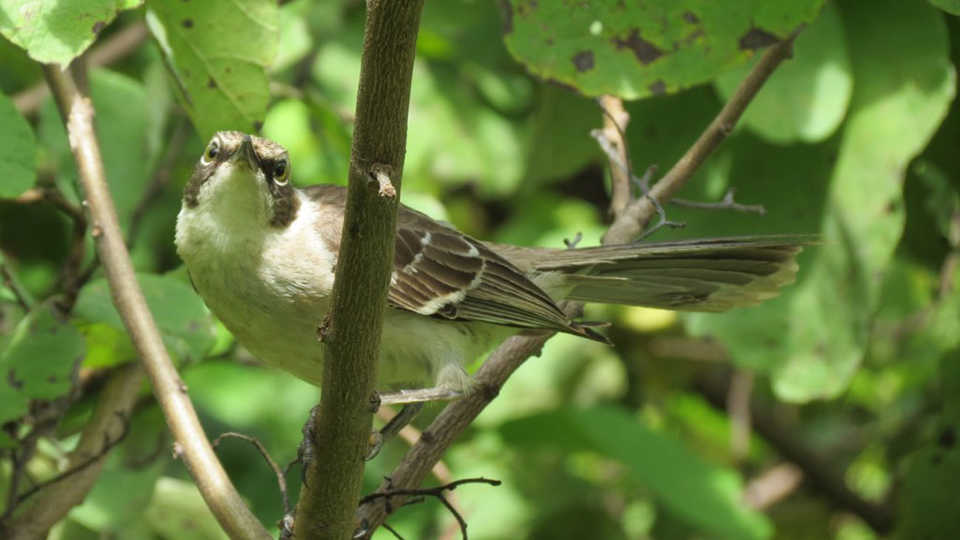
© Jim Moulton
By solving a logic puzzle, students will learn about the speciation of the Galápagos mockingbirds, a group of birds which heavily influenced Darwin's grand idea of evolution through natural selection. With all of the necessary evidence provided, your students can practice reading and constructing a branching diagram showing the evolutionary relationships among this group of birds.
By solving a logic puzzle, students will:
- be introduced to the family of mockingbirds specific to the Galápagos Islands.
- practice reading and constructing branching diagrams showing evolutionary relationships.
- learn that speciation is the process of forming new species.
- Mapping Mockingbirds Student Worksheet (one 11 x 17 sheet per student pair)
- Mapping Mockingbirds Clues (one 8 x 11 sheet per student pair)
- Teacher Answer Sheet
- colored pencils or markers (4 colors per student pair)
- picture of the northern mockingbird
Using a tree from your textbook or another source (a simplified tree of the vertebrates is a classic example), pre-teach vocabulary related to tree structure: lineage, node, descendant, ancestor, diverge, species. It may also be necessary to introduce or review the difference between scientific and common names.
Print out all necessary materials. For younger grades, or to make for a shorter activity, fill in a few answers before making enough copies for student pairs.
Today, students will attempt to solve a puzzle about a group of famous birds called the Galápagos mockingbirds. Has anyone ever seen a mockingbird at their home, in school, or at the park?
- Show a picture of California’s resident species is the Northern Mockingbird, Mimus polyglottos. This bird is famous for singing all day, and imitating other noises, such as another birds’ song or a car alarm. You can recognize it by the white patches that show on its wings when in flight.
- Tell students that a few million years ago, an ancestor of this bird – which looked similar and lived a similar lifestyle – landed on the Galápagos islands. Tell a brief story about how this ancestor diversified into many species, and pass out the worksheet.
- Before passing out the clues, review how to read and construct a family tree, ensuring students understand the symbols in the legend.
- Explain how the puzzle works, pass out clues and markers, and let students work in pairs.
- Review the answers as a class, working through the logic together.
- Keeping answers open-ended, discuss with the students:
» What do you notice about their geographical distribution?
» What can you conclude about their evolutionary relationships?
- Review the branching structure of the family tree to learn how lineages are related.
» In what order did the species branch off from an ancestor? Follow the nodes from left to right. Each signifies a divergence.
- Explain that the wind pattern flows from the southeast to the northwest. Notice the compass. Help students draw appropriate arrows to indicate the wind direction on their maps.
» How is the family tree consistent with this wind pattern? Bird species on southeast islands are older, and more closely related to each other. The wind caused dispersal to the islands to the northwest, resulting in the speciation of two new mockingbirds.
- Suppose you were leading a boat tour around the islands, and part of your job was to act as a field guide for the passengers.
» How would you learn to identify the four types of mockingbirds, so that you could correctly point them out to guests? Depending on which island you disembarked, you would immediately know what mockingbird is likely to cross your path, since their ranges never overlap. Or, you could remember what physical characteristics distinguish each bird, like facial markings.
For high school students, consider discussing the different evidence scientists use to construct cladograms (comparative anatomy, chromosomal DNA, mitochondrial DNA, etc). To receive a copy of the scientific article on which this lesson was based, send a request to teachers@calacademy.org.
ancestor: an earlier organism from which others are derived; a relative from the past
descendant: an organism that derives or descends from an earlier form; future offspring
diverge: to branch off in two directions
endemic: naturally occurring in a certain geographic area, and not found anywhere else
lineage: a continuous line of descent from a particular ancestor
node: the point where a single lineage diverges, or branches off, into two distinct lineages
species: a group of organisms that resemble one another and can produce viable offspring
speciation: the evolutionary formation of new biological species by the branching of one species into two or more distinct ones
The Galápagos Islands are an archipelago consisting of sixteen volcanic islands located 600 miles west of Ecuador in the Pacific Ocean. They formed about 4 million years ago when a series of underwater volcanoes erupted, spewing up magma that cooled to form the cone-shaped islands. When the islands first formed they were devoid of life, but over time animal and plant species colonized them, producing the ecological communities that exist there today.
If you traveled to the islands today, you would certainly hear about the Galápagos mockingbirds, renowned for influencing Charles Darwin’s conception of the theory of natural selection. There are four species in the Galápagos mockingbird genus (Nesomimus). All are endemic to the Galápagos Islands, meaning they are native to these islands and found nowhere else in the world.
Common names:
Galápagos mockingbird
Española mockingbird
San Cristóbal mockingbird
Floreana mockingbird
Scientific names:
Nesomimus parvulus
Nesomimus macdonaldi
Nesomimus melanotis
Nesomimus trifasciatus
Whereas natural selection is one mechanism that works to change characteristics of a certain lineage over time, speciation is the change that results in a lineage actually diversifying into two or more distinct lines. With speciation, changes have occurred to such an extent that populations are no longer breeding, and we can distinguish these organisms as species distinct from each other.
Speciation requires genetic variation just as in natural selection, but often occurs due to populations becoming isolated from one another. Populations may be isolated ecologically, such as those that occupy different niches, competing for different resources at different times in different places. A bird that eats seeds on the ground during the day is not likely to cross paths with one that forages for insects in the treetops at dusk, so they will seldom meet to swap genes. Populations may also be isolated geographically, via separation by landforms, vegetations, or bodies of water. In an archipelago, meeting individuals on your own island to reproduce is less risky than flying between islands each mating season.
Current scientific studies suggest that a single ancestor in the broader mockingbird family (Mimus) colonized the islands several million years ago. Over many generations, groups of mockingbirds either flew or where dispersed by wind to other islands. Being subjected to new environments and competing with others for particular resources, the immigrants adapted via natural selection to their new home. Eventually, the distance between mockingbird populations helped solidify the speciation process. It has been suggested that the prevailing winds in the region, which blow from the southeast to the northwest, influenced mockingbird diversification by dispersing birds to the northwest. Evidence from the branching diagram supports this argument: the birds on the southeast islands are older than those currently inhabited the northwest areas, as shown by a node positioned farther back in time.
To brush up on how to read an evolutionary tree, visit the Understanding Evolution website.
Grade Seven
Life Sciences
-
3d. Students know how to construct a simple branching diagram to classify living groups of organisms by shared derived characteristics and how to expand the diagram to include fossil organisms.
Investigation and Experimentation
- 7d. Construct scale models, maps, and appropriately labeled diagrams to communicate scientific knowledge (e.g., motion of Earth's plates and cell structure).
Mathematical Reasoning
- 1.1 Analyze problems by identifying relationships, distinguishing relevant from irrelevant information, identifying missing information, sequencing and prioritizing information, and observing patterns.
- 2.4 Make and test conjectures by using both inductive and deductive reasoning.
- 2.5 Use a variety of methods, such as words, numbers, symbols, charts, graphs, tables, diagrams, and models, to explain mathematical reasoning.
Grades Nine and Ten
Life Sciences
- 8d. Students know reproductive or geographic isolation affects speciation. Investigation and Experimentation
- 1d. Formulate explanations by using logic and evidence.
- Arbogast, B.S., Drovetski S.V., Curry, R.L., Boag, P.T., Seutin G., Grant, P.R., et al, (2006). The Origin and Diversification of Galapagos Mockingbirds. Evolution, 60(2), 370-382.
- The University of California Museum of Paleontology, Berkeley. (2008). Reading Trees: a quick overview. Understanding Evolution. Berkeley, California. Retrieved April 16, 2008, from http://evolution.berkeley.edu/evolibrary/article/phylogenetics_02.


